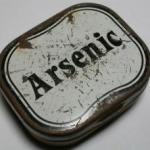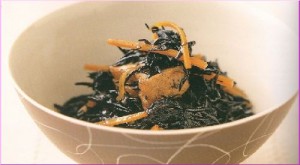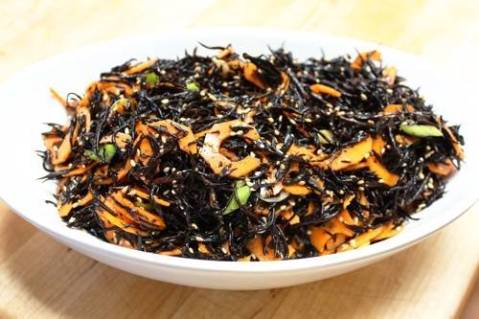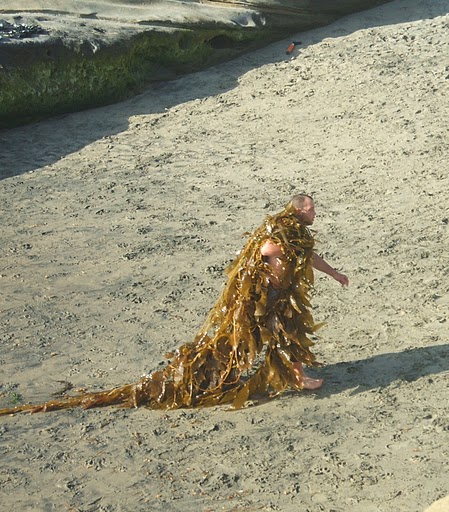Hijiki
April 3, 2011
I like hijiki seaweed. It tastes good when you put it in your mouth. It’s pretty good for you too. Here’s a couple of recipes I like, as well as a few good arguments for and against mass consuption of this yummy sea vegetable.
Hot and cold hijiki/carrot dishes. These recipes also work with wakame, arame, or dulse.
Simmered Hijiki
Ingredients:
1 oz dried hijiki
1 aburaage (fried tofu)
1/4 large carrot
3 TBSP soy sauce
2 TBSP sugar
2 TBSP mirin
3/4 cup dashi stock or water
2 tsp vegetable oil
Procedure:
Put dried hijiki in a bowl. Soak in warm water for 10 minutes. Drain hijiki over a colander. Cut carrot into thin strips. Cut aburaage into thin strips. Heat vegetable oil in a pan and saute carrot and hijiki over medium heat. Add aburaage in the pan and saute lightly. Season with sugar and mirin and stir well. Add soy sauce and dashi (or water), turn to medium high heat, and simmer the ingredients until the liquid is almost gone. Serve warm.
Hijiki and Carrot Salad with Sesame Pineapple Dressing
Ingredients:
2 oz. dried hijiki seaweed
2 large green onions, sliced on the diagonal
2 cups thinly sliced carrots
Sesame Pineapple Dressing:
4 1/2 TBSP seasoned rice vinegar
2 TBSP toasted white sesame seeds
1 TBSP sesame oil
2 TBSP pineapple juice
1 tsp sugar
1 tsp soy sauce
Procedure:
Place the hijiki in a large mixing bowl. Add warm water and mix. Let sit for about 10 minutes, drain in a colander, and rinse with cold water. Drain again thoroughly and place in a mixing bowl. Add the sliced green onions. Thinly slice the carrots into 3 to 4 inch lengths, enough to make about 2 cups. Top the vegetables with the Sesame Pineapple Dressing, and toss to coat. Serve cold.
Health benefits and concerns
Hijiki a.k.a. Hiziki a.k.a. ヒジキ a.k.a. 鹿尾菜 a.k.a. 羊栖菜 a.k.a. Sargassum fusiforme a.k.a. Hizikia fusiformisis, is a type of kelp that grows wild on the coasts of Japan, Korea, and China. It is a traditional Japanese food and is rich in mineral content. Calcium, copper, iodine, iron, magnesium, manganese, molybdenum, phosphorus, potassium, selenium, vanadium, and zinc are found in abundance in all forms of sea vegetables.
 Hijiki also contains highly beneficial phytonutrients, including sulfated polysaccharides that provide anti-inflammatory, anti-viral, and cardiovascular benefits. Hijiki is also an excellent source of vitamin K and a very good source of folate. Kelp also contains measurable levels of polyphenols like carotenoids and flavonoids and other phytonutrient antioxidants, including several types of alkaloids that have been shown to possess antioxidant properties, and is now widely touted as being and anti-cancer food. Cancer research has noted a beneficial effect with regard to kelp consumption and its effect on cancer cells, particularly colon cancer cells. Kelp and other sea vegetables are known for containing a variety of anti-inflammatory and antioxidant compounds. Regular consumption of this combination of nutrients is likely to result in some benefits in the case of colon cancer and other cancer types. Research into this area is ongoing, but kelp is expected to become firmly established as a powerful anti-cancer food as time goes on.
Hijiki also contains highly beneficial phytonutrients, including sulfated polysaccharides that provide anti-inflammatory, anti-viral, and cardiovascular benefits. Hijiki is also an excellent source of vitamin K and a very good source of folate. Kelp also contains measurable levels of polyphenols like carotenoids and flavonoids and other phytonutrient antioxidants, including several types of alkaloids that have been shown to possess antioxidant properties, and is now widely touted as being and anti-cancer food. Cancer research has noted a beneficial effect with regard to kelp consumption and its effect on cancer cells, particularly colon cancer cells. Kelp and other sea vegetables are known for containing a variety of anti-inflammatory and antioxidant compounds. Regular consumption of this combination of nutrients is likely to result in some benefits in the case of colon cancer and other cancer types. Research into this area is ongoing, but kelp is expected to become firmly established as a powerful anti-cancer food as time goes on.
 You should also be aware that hijiki contains a higher percentage of arsenic than other forms of seaweed, so if you’re on some kind of weird macrobiotic seaweed diet, you should keep your daily intake of hijiki below 4.7 grams of dried hijiki. This should not be difficult for the majority of us. The estimated Japanese daily intake is 0.9 grams. Also, the act of soaking and rinsing lowers the arsenic levels by 14%, so as long as you don’t eat a big plate of hijiki every day, you should be fine. If you’re concerned about arsenic levels, stick with wakame or arame. They contain significantly lower levels of arsenic.
You should also be aware that hijiki contains a higher percentage of arsenic than other forms of seaweed, so if you’re on some kind of weird macrobiotic seaweed diet, you should keep your daily intake of hijiki below 4.7 grams of dried hijiki. This should not be difficult for the majority of us. The estimated Japanese daily intake is 0.9 grams. Also, the act of soaking and rinsing lowers the arsenic levels by 14%, so as long as you don’t eat a big plate of hijiki every day, you should be fine. If you’re concerned about arsenic levels, stick with wakame or arame. They contain significantly lower levels of arsenic.
Filed in Food and Drink, Health
Tags: anti-cancer foods, anti-inflammatory foods, anti-viral foods, antioxidants, arame, arame recipe, arsenic, benefits of kelp, benefits of sea vegetable, benefits of seaweed, cardiovascular foods, carotenoids, chinese kelp, colon cancer, dulse, flavonoids, hijiki, hijiki recipe, hijiki salad, hiziki, hizikia fusiformisis, Japanese kelp, kelp, kelp man, korean kelp, macrobiotic diet, meneral content, phytonutrient antioxidants, phytonutrients, polyphenols, polysaccharides, recipe, sargassum fusiforme, sea vegetable, seaweed, seaweed diet, seaweed recipe, simmered hijiki, wakame, wakame recip



